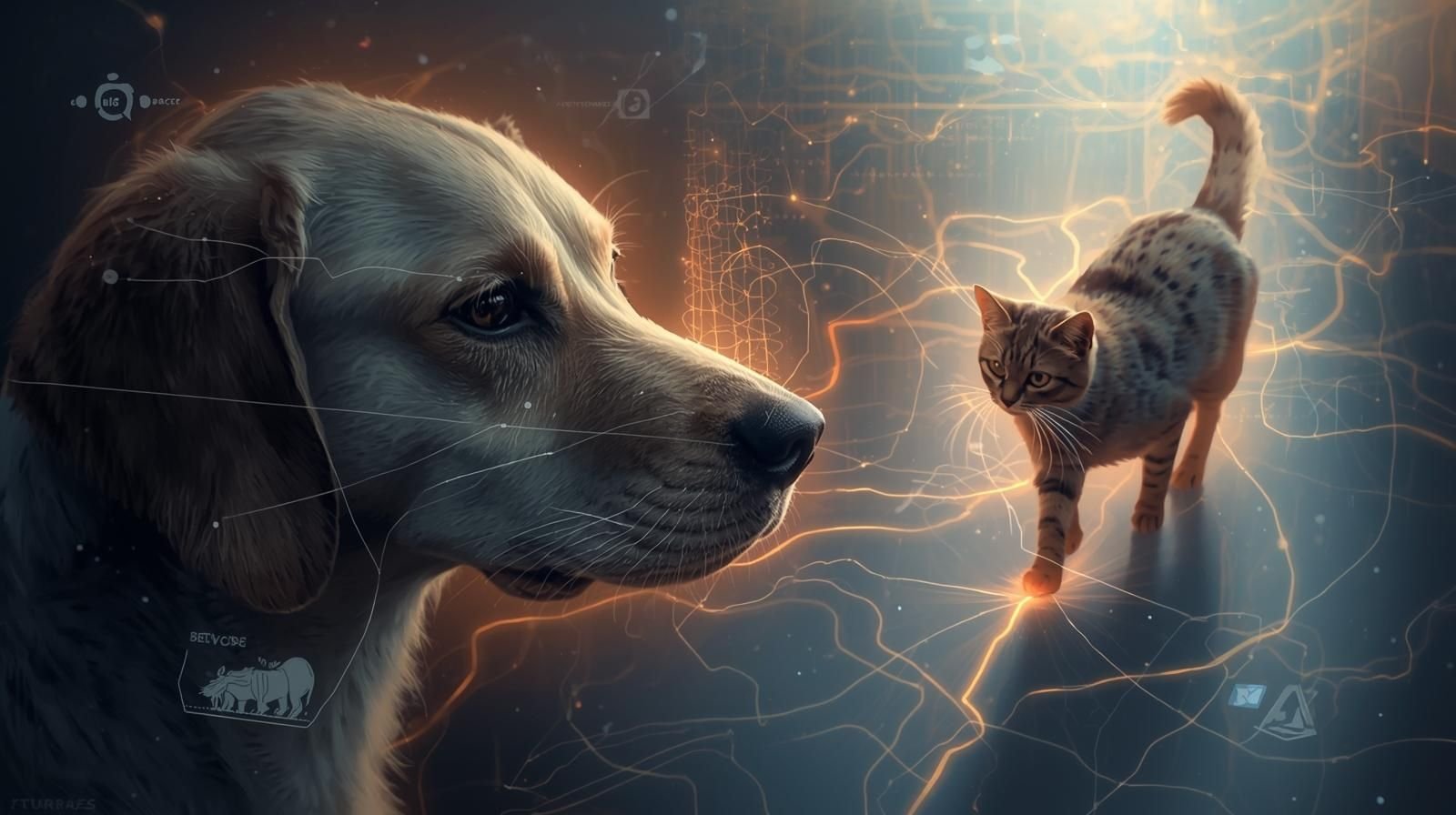New user? Enjoy 10% OFF on your first order. Use code PAW10 during checkout

The intelligence of our beloved cats and dogs extends far beyond basic tricks and house training. Recent scientific breakthroughs have revealed astonishing cognitive abilities that rival those of young children, challenging everything we thought we knew about pet intelligence. From complex language comprehension to sophisticated problem-solving strategies, research shows that our furry companions possess mental capabilities that continue to surprise even leading animal cognition experts.
Dogs Can Master Human Grammar Like Toddlers
One of the most remarkable discoveries in recent years is that highly intelligent dog breeds can learn up to 250 words and actually understand basic grammatical structures. Border Collies and other working breeds have demonstrated the ability to distinguish between “get the ball” and “ball, get it,” showing they comprehend that word order matters in human language.
Research published in 2024 revealed that dogs process human language using both hemispheres of their brain, much like humans do. The left hemisphere focuses on vocabulary while the right processes emotional tone, creating a sophisticated communication system that enables dogs to respond appropriately to complex verbal instructions. This linguistic capability means that the smartest dogs possess cognitive abilities equivalent to those of a 2-year-old child.
Cats Have Fewer Neurons But Use Them More Efficiently
While dogs typically have larger brains with more neurons—golden retrievers possess approximately 623 million neurons compared to cats’ 250 million—cats demonstrate remarkably efficient use of their neural resources. The neuron count advantage doesn’t necessarily translate to superior intelligence, as cats excel in different cognitive domains than dogs.
Studies show that cats have evolved specialized brain regions for independent survival skills, including superior hunting instincts, spatial memory, and environmental awareness. Their cognitive architecture prioritizes self-sufficiency and survival skills, while dogs have developed enhanced social cognition for cooperation with humans.

Dogs Actually Understand Soundboard Communication
The viral phenomenon of dogs using soundboard buttons to “talk” isn’t just clever training—it’s legitimate communication. A groundbreaking 2024 study from UC San Diego proved that dogs trained with soundboards truly comprehend specific words and produce contextually appropriate responses.
The research demonstrated that dogs responded correctly to words like “play” and “outside” regardless of whether the words were spoken by their owners, triggered by button presses, or even pressed by strangers. This suggests dogs process the meaning of words themselves rather than simply responding to visual cues or their owner’s presence, representing a significant breakthrough in understanding interspecies communication.
Puppies Show Advanced Cognition at Just 8 Weeks Old
Perhaps most surprisingly, puppies demonstrate sophisticated cognitive abilities much earlier than previously thought. The Dog Cognitive Development Battery, a series of 14 tasks designed to assess puppy cognition, revealed that 8-10 week old puppies already possess perceptual discrimination, short-term memory, and advanced social communication skills.
Young puppies can respond to human gestures like pointing, demonstrate inhibitory control, and show cognitive flexibility—all indicators of advanced intelligence. These findings suggest that dogs are biologically prepared to communicate with humans from an extremely young age, with these abilities being hardwired rather than learned.
Cats Excel at Independent Problem-Solving
While dogs often look to humans for help when faced with challenging problems, cats prefer to work things out independently. Research using the “unsolvable task paradigm” revealed fundamental differences in problem-solving approaches between the two species. When presented with a container they cannot open, dogs will look to nearby humans for assistance, while cats persistently attempt to solve the problem on their own.
This difference reflects their evolutionary backgrounds—dogs evolved as cooperative pack animals while cats remained primarily solitary hunters. Cats demonstrate superior individual problem-solving skills and show greater persistence when faced with challenging tasks, making them exceptionally skilled at adapting to new environments independently.
Dogs Demonstrate Superior Social Intelligence
Dogs significantly outperform cats in social intelligence tests, particularly those involving human communication cues. In controlled studies comparing both species’ ability to follow human pointing gestures, dogs consistently made more successful choices and showed greater willingness to participate in testing scenarios.
The research found that dogs not only understand human social cues better but actively seek human collaboration when problem-solving. This social intelligence extends to reading human emotions, with dogs capable of detecting emotional states through facial expressions, vocal tones, and even chemical changes in human scent.
Both Species Can Experience Genuine Jealousy
Recent studies have confirmed that both cats and dogs experience genuine jealousy when they observe their owners showing attention to other animals or even fake pets. This emotional response indicates a level of self-awareness and social cognition previously underestimated in domestic animals.
Dogs can literally smell human emotions through chemical changes in our scent, with their sense of smell being approximately 100,000 times more powerful than humans’. This biological empathy allows both cats and dogs to detect their owners’ emotional states before humans are consciously aware of them, explaining their uncanny ability to provide comfort during difficult times.

Cats Navigate Using Magnetic Field Sensitivity
While many people know that certain animals use Earth’s magnetic field for navigation, few realize that domestic cats possess this ability. Research has revealed that cats align themselves with the magnetic field during routine activities, suggesting they use this sensory information to create detailed mental maps of their environment.
This magnetic sensitivity likely contributes to cats’ legendary ability to find their way home over long distances and their exceptional spatial memory within familiar territories. The magnetic navigation system works in conjunction with their other heightened senses to create a comprehensive environmental awareness that aids in both hunting and territorial navigation.
Dogs Can Predict Training Success Through Cognitive Testing
Advanced cognitive testing can now predict which dogs will excel in specialized training programs. Researchers have developed assessment batteries that analyze problem-solving abilities, attention span, memory capacity, and social responsiveness to identify dogs most likely to succeed as service animals or in other demanding roles.
These predictive models have revolutionized training programs by allowing trainers to customize approaches based on individual cognitive profiles. Dogs with strong spatial memory might excel at guide work, while those with superior social cognition could be better suited for therapy roles, maximizing both training success and animal welfare.
Cats Show Environmental Learning Superiority
Cats demonstrate exceptional ability to learn from their environment without direct instruction. Their observational learning skills allow them to master complex behaviors simply by watching other cats or even humans perform tasks. This environmental learning ability reflects their evolution as solitary hunters who needed to acquire survival skills independently.
Unlike dogs, who often require repetitive training sessions, cats can learn new behaviors through minimal exposure and practice. Their learning style emphasizes quality over quantity, with cats often mastering tasks after just a few observations rather than requiring extensive repetition.
Both Species Display Advanced Memory Capabilities
Research has revealed that both cats and dogs possess sophisticated memory systems that extend far beyond simple conditioning. Dogs can remember specific events and experiences for years, while cats demonstrate exceptional spatial memory that allows them to navigate complex territories with precision.
Both species show evidence of episodic memory—the ability to remember specific past experiences in detail—suggesting a level of consciousness and self-awareness that approaches human-like cognition. This advanced memory capability enables both cats and dogs to form lasting emotional bonds with their owners and remember positive and negative experiences throughout their lives.

Intelligence Varies Dramatically by Individual
Perhaps the most important finding in pet intelligence research is that individual variation often exceeds species differences. While average cognitive abilities may differ between cats and dogs, exceptional individuals in both species can demonstrate remarkable intelligence that surpasses typical expectations.
The key to maximizing any pet’s cognitive potential lies in understanding their individual learning style, providing appropriate mental stimulation, and recognizing that intelligence manifests differently across species. Both cats and dogs benefit from cognitive challenges, social interaction, and environments that allow them to express their natural problem-solving abilities.
These discoveries reveal that our pets possess far more sophisticated minds than traditionally believed, with cognitive abilities that continue to surprise researchers and challenge our understanding of animal intelligence. The ongoing research into feline and canine cognition promises even more revelations about the remarkable mental capabilities of our beloved companions.
